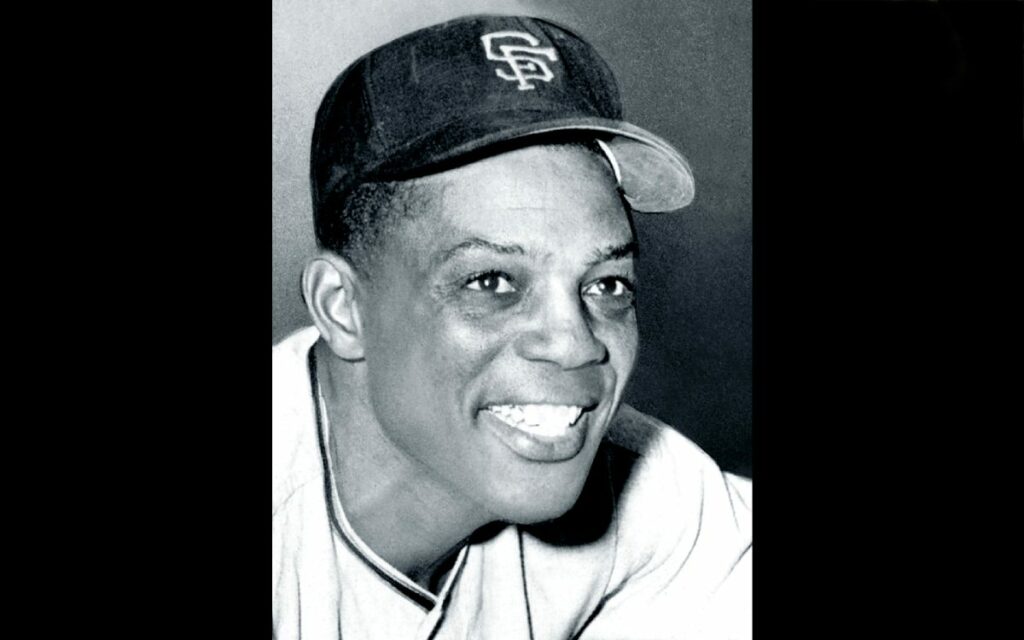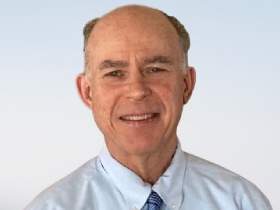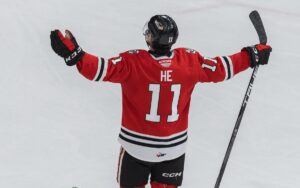
To some, Willie Mays has standing to be called the greatest ballplayer of all time. Pictured: Willie Mays.
In the 1960s sitcom Bewitched, Samantha (a witch played by Elizabeth Montgomery), marries a mortal, Darrin Stevens (Dick York). During a scene in the third season of the series, a Halloween gathering of witches is held at the Steven’s home. As Darrin and Samantha circulate the party Darrin sees Willie Mays talking to Sam’s mother Endora (Agnes Moorehead) and her Uncle Arthur (Paul Lynde).
In a 2012 article in The Hardball Times, Bruce Markusen recounted the scene as follows: Dressed in jacket and tie, a smiling Mays greets Samantha heartily, with Sam returning the greeting with an enthusiastic, “Say hey, Willie.” When Darrin asks Sam, “What’s he doing here?” she responds with a subtle but knowing answer, “Darrin, really.” Darrin then nervously inquires whether Willie Mays is indeed a warlock. Sam delivers a classic response. “The way he hits home runs? What else?” Looking at his watch as he downs another hors d’oeuvre, Mays declares, “Gee, I guess it’s about time for me to pop out to the ballpark.” He then instantly disappears from sight, as a wide-eyed Darrin watches in disbelief.
As far-fetched as that scene was, what Willie Mays did for over twenty seasons as a Major League baseball player could not be summed up as anything less than magical. On June 18th, however, Willie Mays proved to be mortal, passing away at the age of 93. The greatest living ballplayer died, and to some, Mays has standing to be called the greatest ballplayer of all time. Possessing prodigious statistics he can claim a place at the head of any line introducing the greats of the game. He made 24 All-Star games, won 2 NL MVP awards and 12 gold gloves. His numbers are relentless – 660 homers, 3293 hits, 2068 runs scored, and 1909 RBI.
The all-time home run leader, Barry Bonds, said of Mays, “He will always be my mentor and he will always be the person I look up to. It’s really weird because I don’t really feel any different than when I had 400 home runs and he was above me and I have one above him. I still feel he is the greatest ballplayer of all time and that’s just the bottom line to it.”
Keith Hernandez, the long-time first baseman who now broadcasts New York Mets games, basically said the same thing. And in an interview on the Baseball Tonight podcast with Buster Olney, Bob Kendrick, president of the Negro Leagues Museum in Kansas City, spoke from Alabama days before MLB prepared to play a game at Rickwood Field in Birmingham, intended to highlight and honour the players from the Negro League era, but unofficially became a celebration of Mays the player. When asked to comment on Mays’ passing, Kendrick told stories and reflected on the man he had grown to admire and respect.
Kendrick brought great perspective to the situation, noting that he did not think Mays would want the other great Negro League players overshadowed, but it would be hard to avoid seeing the game and the event as anything other than a chance to celebrate Willie Mays. Kendrick reminded everyone that saying the name Willie Mays brings a smile to the face of anyone who saw him play. There are black-and-white images from the 1950s of kids pleading with Willie to join them in Harlem for a game of stickball. Mays emanated a joy for the game that few have ever displayed. His skills were unique and he became the prototypical five-tool player who could throw, had speed, played excellent defence, and could hit for average and power.
As many have pointed out over the past few days, Mays spent most of 1952 and all of 1953 serving in Korea. Those two seasons would probably have produced about 80 homers. It does not take much math to know Mays would have broken Ruth’s home run record in 1972 with Aaron potentially passing him in 1975. And it would be remiss to forget that playing in Candlestick Park in San Francisco for fourteen seasons and the cavernous Polo Grounds the first few years of his career did not help Mays’ home run statistics.
When the game became tilted to pitching in the 1960s, it was Willie Mays who nonetheless hit 52 homers in 1965, the last man to surpass 50 until George Foster of the Reds did it in 1977. While he could not use the World Series as a showcase the way Mantle did with the Yankees, Mays did make perhaps the greatest catch in MLB history in the 1954 series (look it up on YouTube), played in the 1951 series after the Giants made a miracle run to the pennant, and had another chance in 1962, losing to Mantle’s Yankees in seven games. The last years of Mays’ career brought him back to New York where he played a minor role in the Mets’ surprising run to the 1973 World Series. I recall watching that series as the Oakland A’s defeated the Mets in seven games. Willie contributed a couple of hits but made his only fielding error in his twenty World Series games. He retired soon thereafter and was elected with over 94 per cent of the vote on a first-ballot nomination in 1979.
Mays so embodied the game that people as varied as Spike Lee have inquired about honouring Mays with the retirement of his number 24. Some have suggested that could diminish what was done to honour Jackie Robinson who many believe the most important ball player of all time. Interestingly, Robinson’s 42 is just an inversion of Mays’ 24. What might serve as a better memorial would be to turn the image of May’s most famous catch, running with his back to home plate out to the depths of centerfield at the Polo Grounds, as MLB’s logo. Everyone would know who it is, just as everyone knows the NBA logo is the recently deceased Jerry West.
The game at Rickwood Field on Thursday night naturally focused on Willie Mays passing. The fans chanted his name as his son Michael paid tribute, “Birmingham, I’ve been telling y’all that if there’s any way my father could come down here, that he would…Let him hear you. He’s listening. Make all the noise you can.” The players present were honoured as they should be and the integration of Negro League statistics into the Majors will continue to shed light on the third major league that for so long languished in the shadows.
One final argument for Mays as the greatest player of all time comes from Todd Radom, a graphic designer whose logos represent many professional teams and who appears weekly on Olney’s podcast to share different aspects of the game’s history. In conversation with the host, Radom commented, “I am struck by the fact that advanced metrics, modern statistics, back up this claim, that yeah, he [Mays] could well be the greatest player to have ever stepped on the field.” Radom then addressed Mays’ five tools and spoke about a sixth tool: “To be a manager on the field and just his sense around the ball, which transcends the athleticism in a certain way, perhaps sets him apart.” This is the language that people use when talking about a Jordan or James, a Brady or Mahomes, a Gretzky or Orr.
The late Harry Jupiter, who covered the Giants for the San Francisco Chronicle in the 1960s has the last word, “No record book reflects this kind of concentration, determination, perseverance or ability. As a player, Willie Mays could never be captured by mere statistics.”

Dave Redekop is a retired elementary resource teacher who worked part-time at the St. Catharines Courthouse as a Registrar until being appointed Executive Director at Redeemer Bible Church in October 2023. He has worked on political campaigns since high school and attended university in South Carolina for five years, earning a Master’s in American History with a specialization in Civil Rights. Dave loves reading biographies.



















